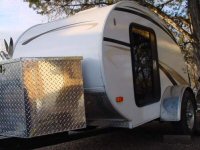eamarquardt wrote:It's not that difficult to replace bearings in the field. You need a drift and a BFH to beat the old race out. Just be careful not to beat the crap (or anything) out of the machined surface of the hub. Then you need a chunk of steel, brass, or aluminum that fits the cup to allow you to "beat" the cup(s) back into the hub. That, unless you get lucky or have access to a lathe, might be a bit tough to procure. A number of auto parts stores will loan out kits with different sized bearing drivers to drive in the new cups. It's not difficult but you have to show some finesse.
That said I think that there are a lot more things likely to fail than a wheel bearing that has been treated nicely (packed well and not submerged under water). Not sure if it's possible to get a spare hub but that could be an easy field expedient spare/repair option.
Cheers,
Gus
Thanks Gus, but I have no access to machine tools, no auto repair experience, and no suitable tools, not even a BFH

Since there is no written history on this trailer, I have no way of knowing if the bearings have been treated nicely in the past, whether they are recent replacements or original equipment. I had a mechanic friend show me how to repack the bearings, and we saw no pitting or spalling so they seem to be in good shape, but could be 65 years old. A spare hub is out of the question since only an old-Ford-expert would be able to tell where the hubs came from.
As far as other things failing, I'm trying to foresee as many of those failure points as possible and have plans for dealing with them. I've already had a flat tire, with no spare, jack, or axle stand, and an electrical fire with no fire extinguisher, so I'd like to be a little better prepared for the next emergency.
<Chas>






 . He has bearings (both cup and cone) for each as well. He even said he will do a little field bearing replacement workshop, but i don't think we will add it to Grant's agenda of activities!
. He has bearings (both cup and cone) for each as well. He even said he will do a little field bearing replacement workshop, but i don't think we will add it to Grant's agenda of activities! 










 Sharon, we will invite you along when Randy "schools" Charley, and anyone else interested. FYI, the type of bearings Charley has are actually two parts for each set up. Th cone (or the "race") and the actual bearing that it sits into. And there are two bearings on each hub, the inner and the outer, which are different sizes
Sharon, we will invite you along when Randy "schools" Charley, and anyone else interested. FYI, the type of bearings Charley has are actually two parts for each set up. Th cone (or the "race") and the actual bearing that it sits into. And there are two bearings on each hub, the inner and the outer, which are different sizes